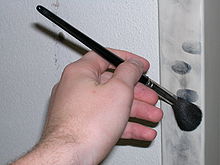Forensics

As forensics (also with Spusi abbreviated) refers to both the activity within the forensics , criminology relevant traces to secure it so to document and ensure, as appropriate ( Forensic Science ), as well as the so commissioned recognition service . It serves as material evidence of the act and perpetration.
history
Securing evidence is traditionally one of the ways investigating authorities use traces left by the crime or the perpetrator to identify the perpetrator or the circumstances of the crime.
description
The securing of evidence is part of the evaluation attack as part of the "first attack" . Securing of evidence includes the search for traces, the recording of traces (numbering, production of images [e.g. photographic, three-dimensional]) and the analysis of traces ( e.g. trace position , trace image , trace comparison). The securing of evidence begins with the so-called crime scene work . It takes its course with evaluations (e.g. investigation, traces of comparison) and ends with the merging of traces of objects and people into objects at the crime scene or on victims and suspects. Theoretically, forensic evidence is based on Locard's rule .
The securing of evidence has the elementary task of securing evidence ; This means that relevant clues and evidence in court are subject to strict control and must therefore be handled professionally.
There are various techniques within forensic evidence, for example dactyloscopy (recording and evaluation of fingerprints ), the collection of body cells (and the subsequent “ genetic fingerprint ”) and detection of blood (for example with luminol ).
Particularly in crime scene situations, care must be taken to ensure that no new leads are set. For this reason, forensic agents wear protective clothing (often Tyvek suits) and cordon off the crime scene from other police officers and, of course, bystanders .
Interpretation of the result
The result of a DNA test, a fingerprint or any other trace alone cannot determine whether a suspect is guilty or not. It is only taken as an indication that must be supplemented by further. Many suspects, however, do confess when confronted with the result. If this is not the case, the result must be interpreted, although false conclusions can not be ruled out.
It must be taken into account that the perpetrator or participant of a crime could possibly have left bogus leads.
execution
In Germany, the " Instructions for crime scene work - traces " (ATOS), which emerged from the no longer current "Guideline (LF) 385 (crime scene work, traces)", are authoritative.
When searching for clues, make sure that no new traces are set. For this purpose, paths are created and the number of access restricted. In addition, it is recorded who entered which room and who made which changes. For outdoor crime scenes, folding pavilions (trace tents) have proven themselves for reasons of privacy protection (e.g. press, curious people), weather protection (precipitation, wind) and for the purpose of protecting evidence.
The recording police officers use various utensils to take the evidence (see evidence case ).
See also
Individual evidence
- ↑ An example of historical regulations for securing evidence is z. B .: Principles for securing tracks and pieces of evidence when a railway crime is discovered . In: Eisenbahndirektion Mainz (ed.): Official Gazette of the Royal Prussian and Grand Ducal Hessian Railway Directorate in Mainz from April 29, 1911, No. 21. Announcement No. 292, p. 135.

